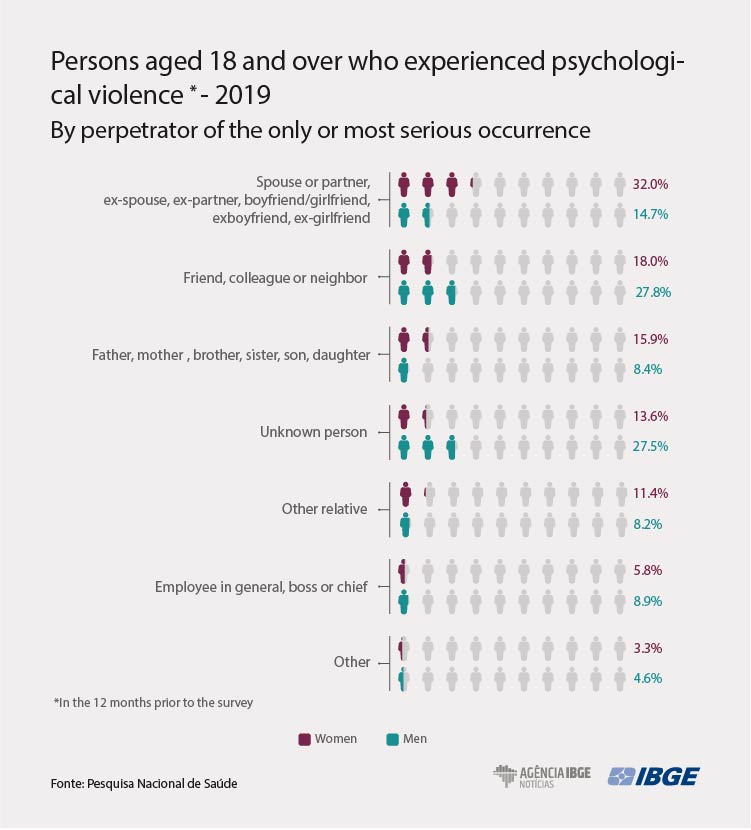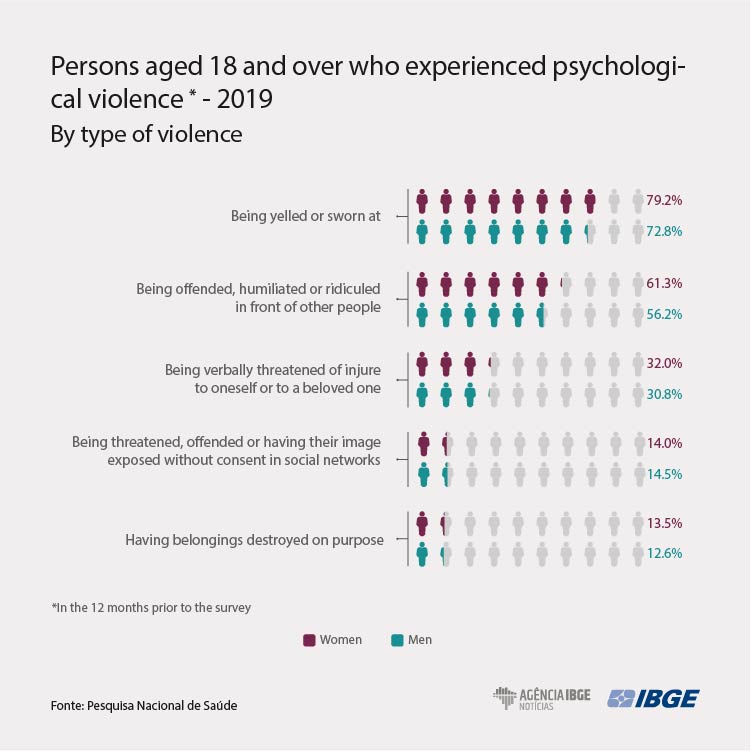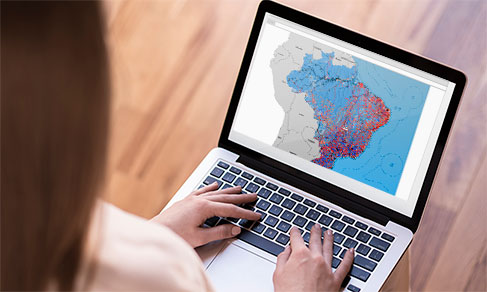National Survey of Health
A total of 29.1 million were affected by violence in 2019, with women, youth and black population as the main victims
May 07, 2021 10h00 AM | Last Updated: May 10, 2021 07h05 PM
Highlights
- A total of 29.1 million persons experienced physical, psychological or sexual violence in 2019; violence affected 19.4% of the women and 17.0% of the men.
- Men are also victims of violence, even sexual violence.
- Partners, ex-partners or relatives are the main perpetrators of violence against women, including physical violence (52.4%), psychological violence (32.0%) and sexual violence (53.3%). The household is the main location where violence takes place.
- Psychological and physical violence against men is perpetrated by non-relatives and is higher out of the household, compared to violence against women.
- Victims of psychological violence correspond to 95.0% of the victims of one of the three types of violence. In 2019, 17.4% of the population – a total 27.6 million persons aged 18 and over – experienced psychological violence.
- Sexual violence led to consequences in psychological (60.2%), physical (19.4%) and sexual (5.0%) terms in the lives of victims.
- Violence interrupted the activities of 3.5 million persons, but only 15.6% sought medical assistance.

In 2019, 29.1 million persons aged 18 and over experienced psychological, physical or sexual violence, in Brazil, according to the National Survey of Health 2019 – Accidents, Violence, Sexually-Transmitted Diseases, Sexual Life, Characteristics of Labor, and Social Support, released today (7), by the IBGE in partnership with the Ministry of Health. That figure corresponds to 18.3% of the residents in the country.
The survey shows that the most affected groups are women, youngsters, blacks or browns and the lower-income population. According to the PNS, the percentage of women experiencing violence is 19.4%, versus 17.0% of men. Among youngsters aged 18 to 29, the percentage reached 27,.%, whereas in the age group 30 to 39, it was 20.4%; 16.5% among adults aged 40 to 59 and 10.1% among those aged 60 and over. Black persons (20.6%) and brown ones (19.3%) were more affected by violence than white persons (16.6%).
The same trend was observed among those in the lowest income range (without income or earning up to 1/4 of a minimum wage), against those in the highest income range (more than 5 minimum wages), 22.5% e and 16.9%, respectively.
“There is a higher incidence of violence among persons in lower-income households. But a correlation between poverty and violence is not possible, since there are other aspects to consider, such as culture, sexism and racism,” says Flavia Vinhaes, analyst of the survey.
Most perpetrators of violence against women are their partners or ex-partners
Partner, ex-partner, boyfriend and ex-boyfriend or a relative were the main perpetrators of violence against women who suffered physical violence (52.4%), psychological violence (32.0%) and sexual violence (53.3%), and that used to take place at home, most often. Considering violence against men, the most common form is psychological aggression and physical assault from friends, colleagues, neighbors and unknown persons in the street.

“The type of violent action and the location where it takes place are correlated information; as the one who perpetrates violence against women is the partner, ex-partner or relative, the household setting is usually where violence takes place. In the case of men, violence is highest out of the housing unit, although psychological violence against men is relatively high in the housing unit, ” says Leonardo Quesada, also a survey analyst.

Victims of psychological violence correspond to 95.0% of the victims of at least one of the three types of violence
In 2019, PNS estimated that 17.4% of the population – a total 27.6 million persons aged 18 and over – experienced psychological violence in the 12 months prior to the survey. Considering that a total of 29.1 million had experienced some type of violence, those affected by psychological violence were 95.0%.
The percentage of female victims was higher than men: 18.6% versus 16.0%. The youngest population (18 to 29 years of age) experienced more psychological violence than the oldest population (persons aged 60 and over), 25.3% versus 9.6% respectively. More black (19.3%) and brown persons (18.3%) underwent that type of violence more than white (15.9%).
Among the types of psychological violence of psychological violence the PNS shows that being offended, humiliated or ridiculed in front of other persons was reported by 59.1% of the victims of both (56.2% of men and 61.3% of women). Having been yelled at or sworn at was mentioned by 76.4% of the victims (72.8% of the men and 79.2% of the women). The survey shows that the type of psychological violence reported by 31.5% of the persons took place when someone verbally threatened to injury them or a beloved one.

Psychological violence is most commonly perpetrated by relatives or partners against women and by persons out of the family circle against men
Against women, psychological violence was most commonly perpetrated by relatives or partners, either close or distant, including persons that were no longer in a relationship with the victim. In the case of male victims, perpetrators were often from out of the family circle.
Ex-spouses, ex-partners or ex-boyfriends/girlfriends are the main perpetrators of violence against women (32.0% versus 14.7% of men). In most cases that person is a male friend, colleague or neighbor of the victim, as mentioned in 27.8% (versus 18% of women); or an unknown person, as mentioned by 27.5% of the men (versus 13.6% of women).
For 55.3% of the women and 26.6% of the men, the household was mentioned as the location for the latest or most serious episode of violence. On the other hand, when considering the street of another public place, the percentage was of 27.6% for men and 15.4% for women. The same trend was identified in terms of psychological violence in the workplace, with 18.4% of the general answers: 13.2% of women and 25.2% of men.
Physical violence affected 6.6 million persons in 2019
PNS 2019 estimated that 6.6 million persons aged 18 and over experienced physical violence in the 12 months prior to the survey, which represents 4.1% of the population. As in psychological violence, more youngsters (aged 18 to 29) experienced physical violence than elderly persons (aged 60 and over), 7.7% versus 1.6%. By color or race, a bigger percentage of black persons (5.2%) and brown persons (4.9%) experienced this type of violence, compared to white persons (3.2%).
Among both women and men, the most frequently reported type of violence was being pushed, held with force of having something thrown at in order to cause injury, 67.4% and 57.5%, respectively. In second place came being slapped (47.6% of women and 37.5%, of men) and, among them, was being threatened or injured with a knife, gun or another type of weapon or object (27.7% of women and 40.9% of men).
As in the case of psychological violence, the most commonly mentioned group of perpetrators of physical violence was the spouse, partner, or boyfriend/girlfriend (including former ones), with 35.9% of the answers, being 52.4% of women and 16.3% of men. That was the other way around in case the perpetrator is unknown (22.1%), as mentioned by 34.5% of the male victims and 11.6% of the female ones.
Physical violence is most frequent in the households of victims (54.0%), being reported by 72.8% of the women and 31.7% of the men. Episodes of violence in public places were 29.0% of the cases, with a highlight to the male sex, with 42.1% of the assaults, against 17.9% of women.
Almost 6% of the population has already experienced sexual violence
In 2019, an estimated 1.2 million persons were victims of sexual violence in the last 12 months preceding the survey; 72.7% of them were women (885 thousand). Youngsters and self-declared black persons were the ones experiencing most violence of the sexual type.
Questions included two specific types of assault: “being touched, handled, kissed or having parts of one’s body exposed against their will” (answered by 79.7% of the victims of sexual violence, 76.1% of the women and 89.3% of the men); and “being threatened or forced to have a sexual intercourse or any type of sexual activity against their will” (answered by 50.3% of those victims, 57.1% of the women and 32.2% of the men).
Similarly to what takes place in psychological and physical violence, the most often mentioned types of perpetrators were partners, ex-partners, or boyfriends/girlfriends, including ex-spouses), mentioned in 45.6% of the cases, being 533% for women and 25.3%, for men. Also mentioned were unknown persons, in 21.8% of the answers (26.3% of the men and 20.1% of the women).
Sexual violence also was also most frequent in the households of victims (52.3%), and, once again, that figure is prevalent among women, since 61.6% of them experienced that type of violence in the housing unit. Among men, that percentage stayed at 27.4%.
The survey also investigated if the person had ever been a victim of sexual violence – not only in the 12 months prior to the survey. It was estimated that 9.4 million persons aged 18 and over were victims of sexual violence, regardless of the reference period, which corresponds to 5.9% of this population, 2.5% of the men and 8.9% of the women.
Violence interrupted the activities of 3.5 million persons, but only 15.6% sought medical assistance
Violence can also be disabling. In Brazil, 3.5 million persons had to interrupt their daily activities as a result of having experienced violence of some kind, which amounts to 12.0% of the victims of psychological, physical or sexual. Once more, women (15.4%) were more affected than men (7.6%) as well as black persons (14.5%, versus 11.0% of white persons and 12.2% of brown ones) and those with an income of up to 1/4 of a minimum wage (20.0%, versus 8.8% of persons with per capita income of more than five minimum wages).
As for consequences, 47.7% of the victims of psychological violence reported psychological consequences to their health. Physical violence caused mainly psychological consequences (77.6%), but also physical ones (33.7%) to victims. Sexual violence also led to psychological (60,2%), physical (19.4%) and sexual (5.0%) consequences to victims.
Among those who reported having had some type of consequence due to having experienced violence, 15.6% of the victims, or 2.3 million persons, sought medical assistance. The percentage of men was 13.2% and the percentage of women, 16.9%. By color or race, the percentages were 17.5% of White persons, 14.8% of brown persons and 13.4% of black persons.


















